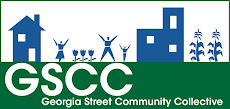

This is a photograph of the second St. Albertus built after 1872. The wooden altars of this church came from the first St. Albertus (built in 1872 - no photographs exist) and were moved to the present church on St. Aubin.

A few of the priests who served the Polish Community.
Second row, third from left: Fr. Jan Mueller (married many at St. Albertus - including my great grandparents) and Fr. Paul Budnik (my great grandfather's cousin).
The nucleus of Detroit's first Polish settlement was formed by a number of Poles who arrived in the city during the middle of the 1850's. As former residents of the Pomerania and Poznan sections of partitioned Poland, then under Prussian rule, the newly arrived Poles settled in and around the city's German-speaking community. Even though few of these Poles attended St. Mary's German Roman Catholic Church on the corner of St. Antonie and Croghan (Monroe) Streets, the majority utilized the facilities of St. Joseph's German Roman Catholic Church first located on Gratiot between Riopelle and Orleans Streets and later on the southwest corner of Orleans and Jay Street. But the Poles were not satisfied with this arrangement (Actually, the Germans forced the Poles to sit in the back of the church....I'm just sayin....) Continuing on...
Desiring to praise God in their native tongue, they began to take steps to organize their own parish in 1870.
Guided by Fr. Simon Wieczorek, CR, who had come down occasionally from Parisville, Huron County, Michigan, to attend to the spiritual needs of his countrymen in Detroit, the Poles organized the St. Stanislaus Kostka Society and began to collect funds for the building of a church. Even though he had some misgivings about the Poles' ability to successfully finance the project, Bishop Caspar Henry Borgess granted his approval.
The plot purchased by the parish committee composed of John Lemke, John Kolodziejczky (I gave up pronouncing that one!), Anthony Treppa, and Anthony Ostrowski comprised lot thirty-six of the old French St. Aubin Farm. Measuring 100 feet wide and 270 feed deep, situated on the western side of St. Aubin Avenue below the southern corner of Fremont (East Canfield) Street, the land cost $600 which was paid in full to the owner Phillip Beaubien. The transaction was completed November 9, 1871.
On this first parcel of St. Albertus Parish's real estate property arose the congregation's first "church and priesthouse." The building contract, dated October 11, 1871, was signed by architect John Wiesenhoffer and thirty charter members of the parish.
Construction of the frame church was begun on June 13, 1872. Bishop Borgess blessed and dedicated the church to St. Wojciech on July 14. Due to difficulties in finding a correct English equivalent for their Polish-Bohemian patron, St. Wojciech, the early pastors and parishioners borrowed the erroneous Latin equivalent Adalbertus, translating into English as St. Albertus or St. Albert.
The opening of St. Albertus led to the movement of the Poles into the neighborhood of St. Aubin and Fremont in order to be close to their own church. This migration resulted in the establishment of Detroit' first Polish neighborhood, known among Detroits as "Poletown;" to the Poles, however, it was "Wojciechowo," (Pronounced "Voy chek ovo") the "District of St. Albertus." (This information attributed to Allan R. Treppa, 1982)
The parish celebrated its Golden Jubilee in 1920. A commemorative booklet contained the names of seventy-two members of the Honorary Committee of the Golden Jubilee, which included some of the names of some of the founders of the parish or their immediate descendants:
Jan
Baka (His descendants guard St. Albertus), Jan
Becker, Edward
Bernack, Jozef
Bialk, Antoni
Boza, Jan
Brzozowski, Marcin
Cwiejkowski, Jozef
Cylke (
Zielke - related to the
Kreft family), Jan
Detloff, Michal
Domzolski, Jan
Dopke, Franciszek
Elwart (related to the
Detloff family), Antoni
Fleming, Jan
Fleming, Sr., Jan
Fleming (Jr.), Jozef
Fleming, Edward
Gajewski, Robert
Glowczewski, Pani
Gneba, Antoni
Gojke (related to the
Kreft and
Budnik families), Jozef
Gojke (see previous), Teofil
Gostomwski, Franciszek
Grenka, Marcin
Grenka, Antoni
Herr, Konstancja
Herr, Pani
Herr & Family, Jan
Hildebrandt, Jozef
Jagla, Jan
Kaminski, Jozef
Karsznia, Albert
Klebba (related to the
Detloff family), Jan
Klebba (see previous), Xavery B.
Konkel (street named for his family and also this is the same family that owned
Konkel Funeral Home), Antoni
Kortas, Julia
Koss, Jan
Kreft (related to the
Zielke,
Lemke,
Detloff,
Czappa,
Budnik and
Gojke families), Marcin
Kulwicki (of
Kulwicki Funeral Home), August
Kuntz, Dr. Stan
Lachajewski, Alexander
Lemke , Bazyli
Lemke, Antoni
Lepke (related to previous), Jozef
Lorkowski, Idzi
Maisel, Franciszek
Majk, Jan
Miotke, Pani
Mulawa, Antoni
Nowe, Jan
Ostrowski (grandson married into the
Malinowski family who married into the
Kreft family), August
Priba, Franciszek
Schmidt, Antoni
Sikora, Jozef
Sikora, Jan
Skrzycki, Tomas
Sobkowiak, August
Steinhabel, Jan
Steinhabel, August
Steiber (later Stobar), Franciszek
Strzyzewski, Antoni
Szkotzke, August
Szornak, Franciszek
Tribeza, Antoni
Trepa, Jan
Wagner, Jan
Welsland, Jakob
Wolff, Bernard
Zentarski (married into the
Gohr,
Malinowski family.
Gohr family also married into the
Biegalski family who married into the
Malinowski family), and Jan
Zynda (who also married into the
Gojke/
Kreft families). (These names are attributed to stalbertus.org but most likely the research of either JGBann or Jim Tye - originally printed in "The Eaglet".)































